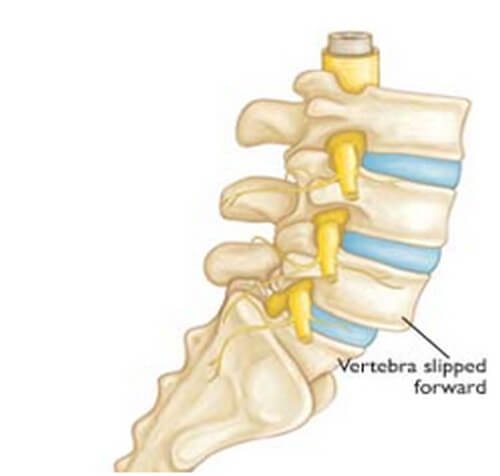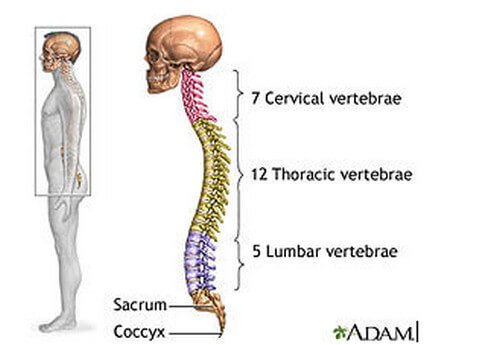Anterolisthesis vs Spondylolisthesis
Spondylolisthesis is the general term for slippage of one vertebra on an adjacent vertebra. The slippage can either be anterolisthesis or retrolisthesis.
Anterolisthesis Definition
Anterolisthesis is derived from two words: ante meaning front and listhesis which means slippage. The condition anterolisthesis is a form of spondylolisthesis where there is anterior displacement or forward slip of the spine. Retrolisthesis, on the other hand, is backward displacement of the vertebral bone in relation to the natural curve of the spine.

Figure 1: Adult anterolisthesis in the low back
(Image source: orthoinfo.aaos.org)
Anatomy of the Spine
In order to understand how anterolisthesis can affect one’s overall health, an overview of the human spine is important. Our spine is made of 33 individual bones stacked one on top of the other. Functions of the spinal column include support for the body and protection of the spinal cord from injury [3]. The bones of the spinal column, called vertebrae, does not only offer protection to the spinal cord.
The manner on how the vertebrae were put together provides enough space for the nerves to be connected to the rest of the body systems for proper functioning. Damage towards the vertebrae would also affect the nerve functioning of a body part or body system that is being supplied by that specific nerve.
The spinal column is divided into regions with specific functions. If you take a look from the side, the overall length of the spine takes a natural S-shaped curve. This allows the body to maintain balance, perform range of motion, and protection as well as it works like a coiled spring to absorb shock [3].
Regions of the Spine

Figure 2: The spinal column and its different regions
(Image source: http://0.tqn.com/y/pilates/1/5/A/A/-/-/ADAMspine.jpg)
- Cervical spine contains 7 vertebrae and its main function is to support and hold the head which weights approximately 10 pounds.
- Thoracic spine contains 12 vertebrae and have a gentle convex curve. This region of the spine has the many number of vertebrae because its main function is to hold the rib or thoracic cage and protect major organs of the body – the lungs and the heart.
- Lumbar spine has 5 vertebrae that supports the weight of the body. If the thoracic spine has the many numbers of vertebrae, the lumbar spine has the largest vertebrae to provide support and prevent injury especially when lifting or hoisting heavy or large objects.
- Sacrum contains 5 vertebrae that are joined together and holds the pelvic girdle.
- Coccyx is comprised of four joined bones that provide connection for ligaments and muscles of the pelvic floor.
Anterolisthesis can happen in any region of the spine but it usually develops in the fourth and fifth lumbar vertebrae [4]. The outcome of the displacement of the vertebrae can result to compression of spinal nerves and other damages in the spinal cord.
Anterolisthesis Symptoms
The clinical presentation of anterolisthesis will depend on the degree of the vertebrae slippage and the location affected by the slippage.
- Lower Back Pain
The most common and possibly initial symptom that will be presented is lower back pain. The pain experienced by the person with anterolisthesis may be localized, meaning it only stays on one area, or widespread [4]. This is due to inflammation of the tissue relative to the disc, nerve roots and spine. At times, the pain can be felt in one or both legs and is also accompanied by weakness or numbness [4,5]. - Difficulty walking
Because of the pain, movement is limited and the person may report difficulty in walking as the pain extends to the legs [5]. - Loss of bladder or bowel control
If the anterolisthesis arise at the lower (lumbar) end of the spinal cord and affects the nerve roots in this area called cauda equina [4,5,6]. As such, symptoms of inability to control urine and bowel in terms of retention and elimination may be a problem. - Limited body movement
The extent of inflammation and pain in the leg, back, or buttocks can lead to limited body movement like bending over or twisting [5].
Anterolisthesis Causes
There are many reasons that can cause anterolisthesis:
- Injury to the spine can lead to forward displacement of the vertebrae [8]. Fractures are the most common reason.
- Persons engaging in strenuous physical activities like weight lifting, gymnastics or football [7].
- Genetics [9]
- Growth of tumor in the spine [4]
- Ageing [4]
Anterolisthesis Risk Factors
The following factors places the person more prone to develop anterolisthesis compared to others”
- Physical factors
- Sex: Males are more common to have anterolisthesis compared to females primarily due to their engaging in more physical activities [7].
- Age: Ageing process could lead to degeneration of bone structure making them more fragile and prone to damage and injuries. Although it’s a natural process, older persons are more likely to develop symptoms of anterolistesis due this reason [4].
- Occupational factors that requires heavy lifting, hyperextension of the body, jumping and other strenuous activities (e.g., athletes, gymnasts, weightlifters, persons engaging in extreme sports, etc.)
Anterolisthesis Diagnosis
There are several diagnostic procedures that can detect and confirm the medical diagnosis of anterolisthesis. Initially, a specialty doctor (Orthopedist) will take the patient’s medical history and perform a physical exam, including checking the patient’s reflexes.
X-rays of the spine will show if any of the vertebrae have fractures or cracks and have slipped out of place [5]. Magnetic resonance imaging (MRI) and CT scan can detect the extent of the slippage and involvement of nerve damage [10].
Anterolisthesis Grading
Extent, severity, and degree of anteroslisthesis is graded according to percentage as soon as diagnostic procedures are completed [4]
- Grade I –25% of forward slippage and considered mild
- Grade II –26% to 50% slippage
- Grade III – about 51% to 75% of forward slippage.
- Grade IV – due to the extent of slippage percentage presented, between 76% to 100% of slippage, this is considered the severe case of anterolisthesis.
- Grade V – a complete fall off from the next vertebra.

Figure 3: Grading of anterolisthesis.
(Image source: www.spineuniverse.com)
Anterolisthesis Treatment
Treatment for anterolisthesis can be divided into two types, depending on the degree or extent of the vertebrae slippage.
Conservative Treatments
Rest
If the condition is mild, the doctor may advise with stopping any physical activity that may have led to vertebrae damage. This will also allow the body to heal naturally, because with sufficient rest, inflammation and pain can be minimized.
Medication Administration and Management of Pain
- It is important to remember that medications can alleviate one’s pain experience, however, patients should also be instructed to watch out for side effects and overuse or dependence to medications.
- Doctors recommend NSAIDS or non-steroidal anti-inflammatory drugs like aspirin, ibuprofen and naproxen.
- These medications provide pain relief without the worries of drug-dependence [11].
- For chronic back pain, opioid therapy is given if the patient does not respond to the first-line of drugs. Take note, this therapy is less ideal because of the danger of dependence and potential toxicity to the body.
- Other medications that are prescribed are muscle relaxants, anti-seizure pain drugs, antidepressants, and steroids taken orally.
Physical Therapy
- Together with medications, doctor would also be recommending physical rehabilitation therapy to help ease the pain, decrease inflammation, increase and promote vitality [11].
- Physical therapy also helps build up stomach and back muscles (core strengthening) [5].
- The physiotherapist may include therapeutic exercises, use of heat and electrotherapy treatments to help achieve the goal of recuperation.
Chiropractic Treatment
- Another traditional treatment that can be considered for anterolisthesis is the manipulation of the bones of the spine to achieve correct alignment.
- Initial physical assessment and medical history taking is conducted to determine if you are qualified for this treatment. Not all persons can receive chiropractic treatment, thus an initial screening is done to detect “red flags”. These would refer to the following conditions [12]:
- Abdominal aortic aneurysm (AAA) – enlargement of the aorta characterized by pulsating mass in the abdomen and pain at rest.
- Cancer
- Infection
- Cauda equina syndrome [4,5,6]
- Compression fractures
Surgery
If conservative treatment does not help at all, surgery is the next option and the type of surgery will depend on the diagnosis, extent and severity of anterolisthesis.
The goals of surgical procedures are:
- Decompression – this is to remove bone or other tissue to release the pressure in the vertebrae
- To fuse the bones in position
- Both decompression and fusion
References:
- Spine-Health – http://www.spine-health.com/glossary/anterolisthesis
- Neuroscience Online – Chapter 3: Anatomy of the Spinal Cord – http://neuroscience.uth.tmc.edu/s2/chapter03.html
- Mayfield Brain & Spine – Anatomy of the Human Spine – http://www.mayfieldclinic.com/PE-AnatSpine.htm
- Anterolisthesis – Grading, Symptoms, Treatment, Causes, Diagnosis – http://byebyedoctor.com/anterolisthesis/
- Spondylolisthesis – Topic Overview – http://www.webmd.com/back-pain/tc/spondylolisthesis-topic-overview
- Cauda Equina Sndrome – http://orthoinfo.aaos.org/topic.cfm?topic=a00362
- Spondylolisthesis: Back Condition and Treatment- http://www.spineuniverse.com/conditions/spondylolisthesis/spondylolisthesis-back-condition-treatment
- What is Anterolisthesis? – http://www.wisegeek.org/what-is-anterolisthesis.htm
- Lumbar Spondylolisthesis or Anterolisthesis: Patient Educational Information http://www.drcharlesblum.com/Patient%20Information/Lumbar%20Spondylolisthesis.pdf
- Cedars-Sinai: Anterolisthesis – https://www.cedars-sinai.edu/Patients/Health-Conditions/Anterolisthesis.aspx
- The American Center for Spine & Neurosurgery: Spondylolisthesis (Cervical) http://www.acsneuro.com/conditions_and_treatments/cervical_spine_detail/spondylolisthesis_cervical
